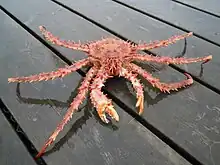Lithodes maja
Lithodes maja, the Norway king crab, northern stone crab,[2] or trollkrabbe (troll crab),[3][4] is a species of king crab which occurs in colder North Atlantic waters off Europe and North America. It is found along the entire coast of Norway, including Svalbard, ranging south into the North Sea and Kattegat, the northern half of the British Isles (with a few records off southwest England), and around the Faroe Islands, Iceland, and off south-eastern Greenland.[1][5][6] In the West Atlantic, it ranges from the Davis Strait between Greenland and Canada south to The Carolinas in the United States.[6][7]
| Lithodes maja | |
|---|---|
 | |
| Lithodes maja caught in Norway | |
| Scientific classification | |
| Domain: | Eukaryota |
| Kingdom: | Animalia |
| Phylum: | Arthropoda |
| Class: | Malacostraca |
| Order: | Decapoda |
| Suborder: | Pleocyemata |
| Infraorder: | Anomura |
| Family: | Lithodidae |
| Genus: | Lithodes |
| Species: | L. maja |
| Binomial name | |
| Lithodes maja | |
| Synonyms | |
The carapace is almost circular and may reach a width of up to 13–14 cm (5.1–5.5 in).[5] The whole body is brown or orange and is covered with large spikes. It lives on both soft and hard bottoms,[1][5] at depths of 10 to 1,000 m (30–3,280 ft).[6] Like most king crabs, females are asymmetrical, with the left side of the abdomen considerably larger than the right, although specimens with the reverse of this are occasionally found.[8]
The low rate of egg production by this species, in comparison to species fished in the North Pacific, limits its abundance, making it unsuitable for commercial exploitation.[9]
However with the collapse of the Alaskan crab fishery (Red King Crab season has been closed for a second straight season 2023, Snow crab is now closed also). Sig Hanson of Deadliest Catch fame is currently in Norway trying to develop a market and fishery on Deadliest Catch: The Viking Returns.
According to their physiological adaptations capabilities, the ideal larval developmental temperatures was thought to between 1–15 °C (34–59 °F), however, from experiment they discovered the optimal temperature is 6 °C (43 °F) instead. In addition, according to Anger K on the temperature and larval development testing, the complete larval development takes 7 weeks at a constant temperature at 9 °C (48 °F).
References
- Cédric d'Udekem d'Acoz (2003). "Lithodes maja (Linnaeus, 1758)". Crustikon – crustacean photographic website. Tromsø Museum – University of Tromsø. Archived from the original on February 19, 2008. Retrieved August 16, 2007.
- katrine. "lithodes maja | The Invertebrate Collections". University Museum of Bergen. Retrieved 2022-09-29.
- River, Julie (2022-10-05). "The Crab Jackpot That Could Convince Deadliest Catch's Jake Anderson To Go Solo". Looper. Retrieved 2023-10-08.
- Moore, Brent (2023-06-06). "What Does Troll Crab Taste Like? Uncovering The Unique Flavors Of This Delicacy". Chef Olu. Retrieved 2023-10-08.
- K. Telnes. "Deepsea king crab". seawater.no. Retrieved May 29, 2019.
- Wilson, E. (2006). "Lithodes maja". MarLIN. Retrieved 29 May 2019.
- "Stone crab, Lithodes maja". Canada's Species. McGill University. Archived from the original on March 14, 2017. Retrieved August 16, 2007.
- S. D. Zaklan (2000). "A case of reversed asymmetry in Lithodes maja (Linnaeus, 1758) (Decapoda, Anomura, Lithodidae)". Crustaceana. 73 (8): 1019–1022. doi:10.1163/156854000504949.
- "Northern stone crab (Lithodes maja) exploratory fishing" (PDF). Government of Newfoundland and Labrador. 2000. Archived from the original (PDF) on May 3, 2007.
Anger, K. “Physiological and Biochemical Changes during Lecithotrophic Larval Development and Early Juvenile Growth in the Northern Stone Crab, Lithodes Maja (Decapoda: Anomura).” SpringerLink, Springer-Verlag, 13 Jan. 1996, link.springer.com/article/10.1007%2FBF00347453.
External links
 Media related to Lithodes maja at Wikimedia Commons
Media related to Lithodes maja at Wikimedia Commons